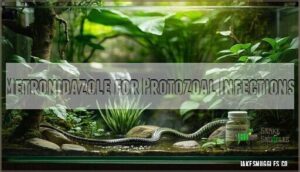This site is supported by our readers. We may earn a commission, at no cost to you, if you purchase through links.

Ivermectin is your go-to treatment, typically administered at 0.2mg/kg subcutaneously every two weeks. Fenbendazole works well for broader nematode infections at 50-100mg/kg orally for 3-5 days.
Don’t forget supportive care – proper hydration, temperature regulation, and stress reduction speed recovery.
Blood tests confirm the microfilaria’s presence, while follow-up testing guarantees treatment success.
Think of it like debugging a computer system – you need the right tools and patience. Your snake’s immune system needs time to clear these microscopic hitchhikers completely.
Table Of Contents
- Key Takeaways
- Understanding Snake Microfilaria
- Diagnosis of Microfilaria in Snakes
- Effective Treatments for Snake Microfilaria
- Managing Snake Nematodes
- Preventing Parasite Infections in Snakes
- Common Parasites in Snakes and Treatment
- Treating Secondary Infections in Snakes
- Post-Treatment Care for Snakes
- Frequently Asked Questions (FAQs)
- How to get rid of snake parasites?
- What kills filarial worms?
- How to treat snake fungal disease?
- Can doxycycline cure microfilaria?
- What is the best treatment for microfilaria?
- Can ivermectin cure microfilaria?
- How do you treat snake nematodes?
- How to get rid of parasites in snakes?
- Can microfilaria be transmitted to humans?
- How common is microfilaria in pet snakes?
- Conclusion
Key Takeaways
- Get veterinary diagnosis first – You’ll need blood tests to confirm microfilaria presence before starting treatment, as proper identification ensures you’re using the right medications for your snake’s specific parasite load.
- Use targeted antiparasitic medications – You’ll treat with ivermectin at 0.2mg/kg subcutaneously every two weeks for microfilaria, or fenbendazole at 50-100mg/kg orally for 3-5 days for broader nematode infections.
- Maintain strict hygiene and isolation – You’ll need to clean enclosures weekly, remove feces immediately, and isolate infected snakes to prevent transmission to other reptiles in your collection.
- Monitor recovery and prevent reinfection – You’ll schedule follow-up blood tests every 4-6 weeks initially, watch for symptom resolution, and implement yearly parasite evaluations to catch future infections early.
Understanding Snake Microfilaria
Snake microfilaria infections occur when parasitic worms release their larvae into your snake’s bloodstream, creating a serious health concern that requires prompt veterinary attention.
Microscopic larvae in your snake’s blood demand immediate veterinary intervention to prevent devastating complications.
You’ll need to recognize the early warning signs and understand proper treatment protocols to protect your reptile’s health and prevent complications.
What is Microfilaria?
Microfilaria represents the larval stage of parasitic worms that circulate through snake blood parasites systems.
These microscopic offspring create serious health challenges when populations multiply unchecked.
Here’s what you need to know about snake microfilaria:
- Microfilaria lifecycle begins when adult worms reproduce, releasing larvae into bloodstream circulation
- Microfilaria morphology features elongated, thread-like structures visible only through microscopic examination techniques
- Snake immunity systems often struggle against overwhelming parasite loads, leading to compromised health
- Geographic prevalence varies substantially, with tropical regions showing higher infection rates
These snake blood parasites disrupt normal physiological functions, making early microfilaria symptoms snakes detection vital for successful treatment outcomes.
How Do Snakes Get Infected?
Understanding how your snake becomes infected with microfilaria is essential for prevention and early intervention.
Vector Transmission occurs primarily through mosquito bites, where infected mosquitoes transfer filarial larvae directly into your snake’s bloodstream during feeding.
Environmental Factors play a significant role in snake parasite infection:
- Prey Contamination: Your snake can contract microfilaria transmission snakes through infected prey animals like rodents or birds
- Mosquito Bites: These blood-sucking insects serve as primary vectors, especially in humid environments where mosquitoes thrive
- Cross-contamination: Snake parasite transmission between animals sharing the same habitat or enclosure increases infection risk
The infection cycle doesn’t align with your snake’s Shedding Cycle, making detection tricky.
Proper Quarantine Procedures for new acquisitions help prevent introducing snake microfilaria into your collection.
Wild-caught snakes pose higher risks than captive-bred specimens due to greater environmental exposure.
Symptoms of Microfilaria in Snakes
Now that you know how snakes get infected, you’ll want to recognize the warning signs.
Snake microfilaria creates several distinct symptoms that signal trouble. Watch for chronic swelling around your snake’s tail and vent area—this screams infection.
Skin lesions often appear as subcutaneous lesions under the surface, creating bumps you can feel. Lethargy signs become obvious when your normally active snake seems sluggish.
Appetite loss follows quickly, turning feeding time into a struggle. Behavior changes like hiding more than usual also indicate snake health problems.
These snake parasite symptoms can lead to serious organ damage if ignored, making early detection your best defense against snake infections.
Diagnosis of Microfilaria in Snakes
Diagnosing microfilaria in your snake requires specific blood tests that detect these microscopic parasites circulating in the bloodstream.
Blood tests reveal the microscopic truth hiding in your snake’s circulation.
Your veterinarian will use a combination of diagnostic methods including fecal examinations and imaging tests to assess the full extent of infection and any potential organ damage**.
Blood Tests for Microfilaria
Several diagnostic methods can detect microfilaria in your snake’s bloodstream. Your veterinarian will select the most appropriate test based on your snake’s condition and symptoms.
Key Blood Testing Methods:
- Direct blood smear analysis – Fresh blood examined under microscope for live microfilaria movement
- Thick blood films – Concentrated samples increase microfilaria detection rates substantially
- Serological testing – Identifies antibodies your snake produces against parasitic infections
- PCR molecular testing – Detects parasite DNA with exceptional test accuracy
- Antigen detection – Locates specific proteins released by adult parasites
- Microfilaria concentration techniques – Filters enhance sample handling and result interpretation
- Staining methods – Chemical dyes make parasites visible during blood smear analysis
- Repeat sampling – Multiple tests confirm snake microfilaria diagnosis and treatment effectiveness
Proper sample handling guarantees accurate results. A microfilaria detection kit can also be utilized. Your vet will explain reptile blood parasites findings and recommend appropriate snake veterinary care protocols.
Fecal Exams for Parasites
Collecting fresh samples properly sets the foundation for accurate snake parasite diagnosis. You’ll need to gather feces within 24 hours for ideal Fecal Smear Prep and Microscopic Identification.
The Fecal Flotation Technique helps separate parasites from debris, making treating snake parasites more targeted. A fecal flotation kit is useful for this process.
Sample Collection Methods vary, but direct collection works best. Interpreting Results requires spotting eggs, larvae, or adult parasites under magnification for effective snake microfilaria treatment of snake internal parasites.
Imaging Tests for Organ Damage
While fecal exams reveal what’s happening in your snake’s digestive tract, imaging tests show you the bigger picture of organ damage throughout your pet’s body.
When microfilaria and other snake internal parasites take hold, they don’t just stay in one place—they can wreak havoc on multiple organ systems.
Ultrasound Detection serves as your first line of defense for snake microfilaria treatment. This non-invasive technique uses sound waves to spot swelling in lymphatic systems and detect fluid buildup that signals infection. Many factors can influence snake ultrasound expenses.
X-Ray Analysis provides crystal-clear views of structural damage, revealing how parasites have affected your snake’s internal architecture. CT Scan technology takes things further, creating detailed cross-sectional images that pinpoint exactly where damage has occurred.
MRI Usage offers the most thorough view when Damage Severity needs precise assessment. These imaging tests for treating snake parasites help your vet map out a targeted treatment plan.
Here’s what these tests typically reveal:
- Lymphatic system swelling and blockages
- Organ inflammation and structural changes
- Fluid accumulation in body cavities
Effective Treatments for Snake Microfilaria
When your snake tests positive for microfilaria, you’ll need targeted medications to eliminate these parasitic worms from their bloodstream.
The good news is that several proven treatments can effectively clear these infections when administered properly by a veterinarian.
Ivermectin for Microfilaria
Ivermectin stands as your most reliable weapon against snake microfilaria. This anthelmintic medication targets parasites’ nervous systems, causing paralysis and death.
The standard ivermectin dosage for treating infected snakes is 200 mcg/kg, repeated after 14 days. Watch for side effects like lethargy or appetite loss.
While resistance concerns exist with overuse, preventative use isn’t recommended. This powerful treatment handles filarial infections effectively when properly administered.
It’s important to note that reptile parasiticides should be selected carefully based on the species.
Fenbendazole for Nematode Infections
When treating nematode infections in snakes, fenbendazole stands as your go-to anthelmintic medication. This benzimidazole drug works by binding to parasite microtubules, disrupting their glucose uptake and ultimately paralyzing the worms.
Fenbendazole Dosage typically ranges from 25-100 mg/kg given orally for 3-5 consecutive days. For severe infections, you’ll want to use 50 mg/kg daily. Treatment Duration often requires repeating the course after 10-14 days to catch any remaining parasites.
Here’s what you need to know about using fenbendazole effectively:
- Accuracy matters – Calculate dosage precisely based on your snake’s weight to avoid toxicity
- Monitor for Side Effects – Watch for lethargy or appetite loss, though adverse reactions are rare
- Consider Resistance Concerns – Some nematode populations may not respond, requiring Alternative Anthelmintics
Fenbendazole achieves over 98% efficacy rates against most nematodes, making it extremely effective for treating infected snakes. The drug’s wide safety margin means you can confidently use it without major worry about overdose at therapeutic levels. It’s often favored due to its safety in reptiles.
Metronidazole for Protozoal Infections
When treating protozoal infections in your snake, metronidazole stands as your reliable ally.
This medication targets troublesome parasites like trichomonads and amoebic infections with proven efficacy over 45 years of veterinary use.
| Treatment Aspect | Key Details |
|---|---|
| Dosage Guidelines | 20-50 mg/kg every 24-48 hours |
| Treatment Duration | 2-5 doses based on severity |
| Peak Effectiveness | 1.4-4 hours post-administration |
| Common Side Effects | Lethargy, vomiting, neurological signs |
| Alternative Treatments | Paromomycin for resistant cases |
Monitor your snake closely during treatment, as proper dosing prevents toxicity while ensuring complete parasite elimination.
Managing Snake Nematodes
When dealing with nematodes in your snake, you’ll need targeted antiparasitic medications that specifically attack these roundworm parasites.
The three main treatment options – thiabendazole, levamisole, and piperazine – each work differently to eliminate nematodes and restore your snake’s health.
Thiabendazole for Nematode Treatment
Thiabendazole stands out as a reliable anthelmintic medication for treating nematode infections in snakes. This benzimidazole compound works by disrupting parasite metabolism, making it highly effective against strongyloides, ascarids, and hookworms.
Thiabendazole Dosage typically ranges from 50-100 mg/kg given orally, with Treatment Duration involving a second dose two weeks later. Your vet will determine the exact amount based on your snake’s weight and species.
While generally safe, Side Effects can include mild gastrointestinal upset like vomiting or lethargy. Monitor your snake closely during treatment – these symptoms usually resolve within 1-2 days.
Resistance Concerns are minimal with thiabendazole, though completing the full treatment course prevents this issue. If parasites persist after treatment, Alternative Anthelmintics like fenbendazole or levamisole offer backup options for stubborn infections. Regular fecal testing is vital for ongoing monitoring. Fecal exams after treatment confirm successful snake parasite treatment and address your snake’s snake microfilaria concerns properly.
Levamisole for Nematode Control
Levamisole stands out as a powerhouse medication for tackling nematode infections in your snake. This snake parasite treatment works by targeting the nervous system of parasites, causing paralysis and elimination.
When considering Levamisole dosage, you’ll typically see 5-10 mg/kg administered orally or subcutaneously. Your vet will calculate the exact amount based on your snake’s weight.
The safety profile is generally good when dosed correctly, though you should watch for signs like excessive salivation or muscle tremors.
Resistance concerns make rotation with alternative anthelmintics important. Some vets recommend combination therapies for stubborn cases.
Levamisole’s nematode control effectiveness makes it a go-to choice for snake microfilaria management, but proper veterinary guidance guarantees the best outcomes.
Piperazine for Nematode Elimination
When dealing with nematode infections, you’ll find piperazine stands as a reliable ally in your snake care toolkit.
This medication works through a unique Piperazine Mechanism that blocks nerve signals, effectively paralyzing these unwanted parasites and allowing your snake’s natural defenses to clear them out.
Piperazine Dosage typically ranges from 100-200 mg/kg, though you’ll want your vet to confirm the exact amount.
Piperazine Safety is generally excellent when used correctly, making it a trusted choice among reptile keepers.
Consider these treatment scenarios:
- Your ball python showing decreased appetite after a recent feeding issue
- Multiple snakes in your collection displaying similar symptoms
- Prevention protocols for newly acquired animals
While Piperazine Resistance remains rare, having Piperazine Alternatives like fenbendazole ready guarantees you’re prepared for any situation requiring snake parasite medication adjustments.
Preventing Parasite Infections in Snakes
Prevention works better than treatment in the case of snake parasites.
You’ll save time, money, and stress by establishing solid prevention practices that keep microfilaria and other parasites from taking hold in your snake collection.
This approach allows for a more proactive and effective management of snake health.
Proper Sanitation and Hygiene
You’ll want to think of Enclosure Cleaning as your first line of defense against snake microfilaria and other parasites.
Clean your snake’s habitat weekly using reptile-safe disinfectants that won’t harm your pet.
Feces Removal should happen immediately – parasites love contaminated environments.
Replace soiled substrate regularly since it can harbor eggs and larvae.
Water Quality matters too.
Change water bowls frequently and disinfect them thoroughly.
Focus on corners, hiding spots, and decorations where parasites might hide.
After cleaning, rinse everything completely to remove disinfectant residue that could irritate your snake.
Good Substrate Management means choosing materials that drain well and resist moisture buildup.
Damp conditions create perfect breeding grounds for parasites.
Remember, snake parasite control starts with consistent cleaning habits.
While treatments like Ivermectin and Fenbendazole handle existing infections, proper snake parasite treatment begins with prevention through excellent hygiene practices in your snake’s home.
Isolation of Infected Snakes
Your snake’s health depends on quick isolation when you spot microfilaria signs.
Quarantine protocols protect your entire collection from filarial infections spreading like wildfire.
- Immediate enclosure separation – Move infected snake to dedicated quarantine space
- Transmission prevention measures – Use separate feeding tools and cleaning equipment
- Zoonotic risks assessment – Wash hands thoroughly after handling infected animals
- Care adjustments planning – Prepare for Ivermectin treatment and anthelmintics administration
Yearly Evaluations for Parasites
Beyond isolation protocols, yearly evaluations serve as your snake’s annual health insurance policy.
Schedule thorough parasite screenings to catch filarial infections and other parasites before they become serious problems.
Early detection through regular testing frequency saves money on extensive treatments later.
Consider preventative medication based on your vet’s recommendations.
These cost considerations pale compared to treating advanced microfilaria in reptiles infections.
Regular checkups can help with detecting health problems early on.
Common Parasites in Snakes and Treatment
Beyond microfilaria, your snake can face several other parasitic threats that require specific treatment approaches.
Understanding these common parasites and their targeted treatments will help you provide thorough care when your reptile companion needs it most, ensuring you can offer the best support with complete concepts of parasite management.
Cestodes and Treatment Options
Tapeworm identification starts with recognizing these flat, segmented parasites in your snake’s digestive system.
Cestodes require targeted medication options for effective elimination.
Niclosamide treatment disrupts the worm’s energy metabolism, while bunamidine HCl offers reliable parasite control.
Praziquantel dosage provides broad-spectrum effectiveness against multiple tapeworm species.
These snake parasite treatment options work by targeting different biological pathways, ensuring thorough parasite elimination and reinfection prevention in your reptile’s system.
Trematodes and Treatment Options
Trematodes, or flukes, can wreak havoc on your snake’s digestive tract, lungs, and urinary system.
These parasites present diagnosis challenges due to their complex fluke lifecycle. Fortunately, effective medication options exist to combat these unwelcome guests.
Treatment relies on two primary medications:
- Praziquantel – First-line treatment with proven efficacy against trematodes
- Fenbendazole – Broad-spectrum alternative showing strong fenbendazole efficacy.
Praziquantel dosage varies by species, making veterinary consultation essential.
While Ivermectin works well for snake microfilaria, it’s less effective against trematodes. Trematode resistance remains uncommon, but proper dosing prevents treatment failures.
Acanthocephalans and Treatment Options
Dealing with thorny-headed worms requires patience since these stubborn parasites resist many standard treatments.
Acanthocephalans primarily affect aquatic reptiles but can infect snakes through contaminated prey.
Levamisole remains your best medication option, while Ivermectin and Fenbendazole typically prove ineffective.
Prevention strategies focus on quarantining new arrivals and proper sanitation to break transmission cycles.
*Typically ineffective
Treating Secondary Infections in Snakes
When your snake battles microfilaria, secondary infections can sneak in through weakened defenses, making treatment more complex than you’d expect.
You’ll need to tackle bacterial, fungal, and viral complications alongside the primary parasite problem to guarantee your snake makes a full recovery.
Bacterial Infections and Antibiotics
When parasites weaken your snake’s immune system, bacterial infections often follow as opportunistic invaders.
These secondary bacterial infections can complicate recovery and require prompt attention.
Bacterial identification through culture testing helps determine the specific pathogen.
Common culprits include Enterococcus faecalis, Morganella morganii, and Aeromonas hydrophila.
Each requires targeted antibiotic selection based on sensitivity results.
Antibiotic resistance poses growing challenges in snake disease treatment.
Many gram-negative bacteria now resist standard medications, making culture-guided therapy essential.
Enrofloxacin (5-10 mg/kg daily) and ceftazidime (20-40 mg/kg every 2-3 days) prove effective against most resistant strains.
Dosage considerations vary by species and infection severity.
Gentamicin requires careful hydration monitoring due to kidney toxicity risks.
SMZ-TMP works well for digestive tract infections alongside snake microfilaria treatment.
Infection prevention through proper enclosure hygiene and stress reduction keeps your snake’s defenses strong during snake medication protocols.
Fungal Infections and Antifungals
While bacterial infections steal the spotlight, fungal infections can sneak up on your snake just as fast.
Snake fungal disease (SFD) caused by Ophidiomyces ophiodiicola affects dozens of species across North America, creating facial swelling and ulcerations that spread rapidly.
Your antifungal arsenal includes:
- Miconazole Treatment – Your first line of defense against surface infections
- Ketoconazole Use – Tackles deeper systemic fungal problems effectively
- Amphotericin B – The heavy hitter for severe cases
Fungal Diagnosis requires identifying lesions and confirming through culture or DNA testing.
Infection Prevention starts with proper sanitation since these environmental fungi thrive in contaminated substrates.
Viral Infections and Antivirals
While fungal infections target the snake’s external surfaces, viral infections pose a different challenge for your reptile’s internal systems. Snake Viruses like paramyxovirus, adenovirus, and reovirus can wreak havoc on respiratory, digestive, and nervous systems. Unfortunately, Antiviral Efficacy remains limited in reptile medicine, with few proven treatments available.
Viral Diagnosis requires specialized testing since symptoms often mimic other conditions. You’ll need veterinary expertise to distinguish viral from bacterial causes. Supportive Care becomes your primary weapon against these infections, focusing on maintaining hydration, nutrition, and environmental stability.
Here’s what makes viral infections particularly challenging:
- Limited antiviral options – Unlike bacterial infections, few medications effectively combat snake diseases
- Rapid progression – Viruses can quickly overwhelm weakened immune systems
- Contagious nature – Emerging Viruses spread easily between reptiles in collections
- Subtle early symptoms – Early detection proves difficult, delaying snake treatment
Prevention through proper quarantine protocols and excellent husbandry remains your best defense against viral complications in snake microfilaria cases.
Post-Treatment Care for Snakes
Once you’ve successfully treated your snake’s microfilaria, the work isn’t over—proper post-treatment care guarantees complete recovery and prevents reinfection.
You’ll need to monitor your snake closely for several weeks, watching for any signs that parasites might return while supporting their body’s healing process.
Monitoring for Recurrence
Success doesn’t end when treatment finishes – it’s just the beginning of vigilant post-treatment surveillance. Your snake needs ongoing monitoring to catch any sneaky snake microfilaria trying to make a comeback. Repeat blood smears become your best defense, revealing microscopic troublemakers before they multiply.
Schedule follow-up appointments every 4-6 weeks initially, then quarterly for the first year. Your vet will track hematologic parameter monitoring, checking blood counts and protein levels that indicate filarial infections.
Watch for clinical sign resolution – appetite should improve, swelling should decrease, and energy levels should return to normal. Environmental recontamination poses real risks, so maintain pristine enclosure conditions.
If ivermectin or other antifilarial drugs successfully cleared the infection, you’ll see steady improvement in blood work. However, incomplete treatment cycles can lead to resistant parasites. Monitoring recurrence means staying alert to subtle changes in behavior, feeding patterns, or physical appearance that might signal the parasites’ return.
Wound Care and Management
Three key steps guarantee your snake heals properly after treating snake microfilaria and filarial infections. Daily cleaning with povidone-iodine prevents secondary infections while promoting tissue regeneration.
Monitor closely for complications that could derail recovery. Cleaning snake wounds requires gentle techniques.
- Clean wounds daily with sterile saline and apply povidone-iodine solution
- Watch for swelling, discharge, or redness indicating secondary infections
- Support lymphedema reduction through gentle wound massage techniques
- Document healing progress and contact your vet if recovery stalls
Proper wound care after Ivermectin or Fenbendazole treatment accelerates healing and prevents setbacks, ensuring a successful recovery with daily cleaning and proper veterinary guidance.
Nutritional Support for Recovery
After addressing wound care, your snake’s recovery hinges on proper nutrition. Think of food as medicine—it fuels healing from the inside out.
Dietary Adjustments: Your vet will likely recommend protein-rich meals to rebuild damaged tissues. High-quality whole prey or specialized commercial diets provide essential amino acids your snake needs. Boosting immunity requires balanced nutrition, not just any meal.
Appetite Stimulation: Some snakes lose interest in food after treatment with Ivermectin or Fenbendazole. Warming prey slightly or offering favorite items can reignite their appetite. Patience pays off here.
Hydration Strategies: Fresh water should always be available. Dehydrated snakes recover slower from snake microfilaria infections.
Supplementation Needs: Your vet might suggest omega-3 supplements or probiotics for gut health. These support overall snake care during recovery.
Here’s what proper nutritional support means for your snake:
- Faster tissue repair – Quality protein accelerates healing
- Stronger immune response – Balanced nutrition fights future infections
- Restored energy levels – Proper fuel helps them bounce back quicker
Frequently Asked Questions (FAQs)
How to get rid of snake parasites?
You’ll need veterinary-prescribed medications like ivermectin for microfilaria, fenbendazole for nematodes, and praziquantel for tapeworms. Clean enclosures regularly, isolate infected snakes, and schedule yearly parasite evaluations for prevention.
What kills filarial worms?
Nearly 200 million people worldwide suffer from filarial infections. You’ll find ivermectin most effective – it paralyzes microfilariae and blocks reproduction. Doxycycline targets essential bacteria, while diethylcarbamazine eliminates adult worms completely.
How to treat snake fungal disease?
You’ll treat snake fungal disease using antifungal medications like miconazole, ketoconazole, or amphotericin B.
Your vet will prescribe the right medication and dosage based on the infection’s severity and your snake’s condition, using medications such as amphotericin B.
Can doxycycline cure microfilaria?
Doxycycline doesn’t directly kill microfilaria but targets Wolbachia bacteria inside adult worms. You’ll need ivermectin or fenbendazole for snakes to effectively eliminate microfilaria infections.
What is the best treatment for microfilaria?
Picture tiny worms wreaking havoc in your bloodstream—that’s microfilaria for you.
Ivermectin stands as the gold standard treatment, effectively paralyzing these microscopic parasites while your immune system finishes the job.
Can ivermectin cure microfilaria?
Ivermectin effectively treats microfilaria by paralyzing and killing these parasitic larvae. You’ll see significant reduction in microfilarial counts, though it doesn’t eliminate adult worms completely, requiring multiple treatments.
How do you treat snake nematodes?
You’ll need specific antiparasitic medications for snake nematodes. Fenbendazole and levamisole are your go-to treatments, showing excellent results with 90% efficacy rates. Ivermectin also works effectively against various nematode species.
How to get rid of parasites in snakes?
Like untangling a web, you’ll treat snake parasites with targeted medications.
Use ivermectin for microfilaria, fenbendazole for nematodes, and praziquantel for tapeworms.
Clean enclosures regularly and isolate infected snakes to prevent the spread.
Can microfilaria be transmitted to humans?
Yes, snake microfilaria can potentially be transmitted to humans through mosquito bites, though it’s uncommon.
You’d need exposure to infected mosquitoes that previously fed on parasitized snakes to contract these filarial worms.
How common is microfilaria in pet snakes?
Picture your beloved snake coiled peacefully, yet beneath its scales, microscopic invaders might lurk.
Microfilaria isn’t common in captive snakes but occasionally affects imported or wild-caught specimens.
Regular veterinary checkups help catch these sneaky parasites early, and it’s crucial for the health of your snake to identify microscopic invaders.
Conclusion
Successfully treating snake microfilaria is like solving a complex puzzle – each piece must fit perfectly.
You’ll need veterinary expertise to determine the right antiparasitic protocol for your specific situation.
Remember that learning how to treat snake microfilaria requires patience and consistency.
Follow your vet’s medication schedule precisely, maintain proper husbandry conditions, and monitor your snake’s progress closely.
With dedicated care and professional guidance, you can eliminate these parasites and restore your snake’s health completely.
- https://www.entomoljournal.com/archives/2023/vol11issue2/PartB/11-2-35-735.pdf
- https://www.infontd.org/ntds/lymphatic-filariasis
- https://www.merckvetmanual.com/exotic-and-laboratory-animals/reptiles/clinical-procedures-for-reptiles
- https://www.cdc.gov/filarial-worms/hcp/clinical-care/index.html
- https://emedicine.medscape.com/article/217776-treatment

















